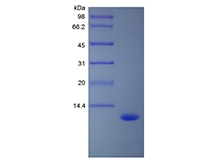| Official Full Name |
Recombinant Human Macrophage Inflammatory Protein-5/CCL15 (rHuMIP-5/CCL15) |
| Squence |
 |
| Amino Acid Sequence |
QFINDAETEL MMSKLPLENP VVLNSFHFAA DCCTSYISQS IPCSLMKSYF ETSSECSKPG VIFLTKKGRQ VCAKPSGPGV QDCMKKLKPY SI |
| Synonyms |
C-C Motif Chemokine 15, LKN-1, Mrp-2b, NCC-3, Small-inducible Cytokine A15 |
| Accession Number |
Q16663 |
| GeneID |
6359 |
| Summary |
Human CCL15 is belonging to the CC chemokine family and shares 35 % amino acid homology with human HCC1 (CCL14). CCL15 is most abundant in heart, skeletal muscle and adrenal gland, and low expressed in liver, small intestine, colon, and in certain leukocytes and macrophages of the lung. It is chemotactic for neutrophils, monocytes, and lymphocytes and elicits its effects by binding to cell surface chemokine receptors like CCR1 and CCR3. CCL15 has several cleaved chains. All of them are more potent chemoattractants than CCL15. |
| Source |
Escherichia coli. |
| Molecular Weight |
Approximately 10.2 kDa, a single non-glycosylated polypeptide chain containing 92 amino acids. |
| Biological Activity |
Fully biologically active when compared to standard. The biological activity determined by a chemotaxis bioassay using human T-lymphocytes is in a concentration range of 1.0-10 ng/ml. |
| Appearance |
Sterile filtered white lyophilized (freeze-dried) powder. |
| Formulation |
Lyophilized from a 0.2 um filtered concentrated solution in 20 mM PB, pH 7.4, 100 mM NaCl. |
| Endotoxin |
Less than 1 EU/ug of rHuMIP-5/CCL15 as determined by LAL method. |
| Reconstitution |
We recommend that this vial be briefly centrifuged prior to opening to bring the contents to the bottom. Reconstitute in sterile distilled water or aqueous buffer containing 0.1 % BSA to a concentration of 0.1-1.0 mg/mL. Stock solutions should be apportioned into working aliquots and stored at ≤ -20°C. Further dilutions should be made in appropriate buffered solutions. |
| Stability and Storage |
Use a manual defrost freezer and avoid repeated freeze-thaw cycles.- 12 months from date of receipt, -20 to -70 °C as supplied.- 1 month, 2 to 8 °C under sterile conditions after reconstitution.- 3 months, -20 to -70 °C under sterile conditions after reconstitution. |
| References |
|
| SDS-PAGE |
 |
| Safety Data Sheet (SDS) Download |
Click to download |
| Technical Data Sheet (TDS) Download |
Click to download |



